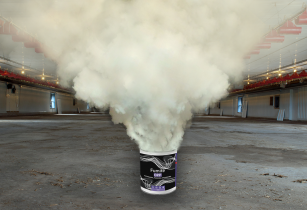African Farming spoke with Octavius Hunt, UK -based manufacturer of smoke generators that provide effective solutions for pest and disease management
They are used in various applications including grain and food storage, crop protection, disinfection as well as public health and include products that offer natural treatment to combat the menace.
Smoke generators also referred to as fumigators or smoke bombs are potent against a broad range of pests and insects, offering a rapid knockdown and kill effect, besides helping to prevent numerous diseases.
Nick Dale, managing director, Octavius Hunt, said, “By including smoke generators as part of their treatment plan for pests, farmers can ensure the protection of crop as well as the hygiene safety of livestock and poultry.”
 The technology
The technology
The development and manufacture of smoke generators involve a unique blend of formulation skills and production expertise. It consists of four elements: an active ingredient, a fuel source, an oxidant and an inert or bulk carrier. The components are mixed together in a precise formulation and are packed into easy to use canisters (generators) or compressed into pellets. The smoke generators are ignited through the use of slow-burning pre-formed wicks and all components are contained within the pre-dosed canisters. Once the generators are lit, the fully sealed treatment area is left undisturbed for a minimum of two hours. The controlled combustion forces out smoke particles carrying the active particles which rise in a column to the roof of the enclosed space and subsequently fall as they cool, descending to settle on all surfaces within the treatment area. Following the required treatment time, users ventilate the area for another two hours.

Advantages of smoke generators
The rapid smoke output of a generator enables the active ingredient to be carried throughout the treatment area, accessing roofs, cracks, crevices as well as inside machinery, with deposits on all surface areas both vertical and horizontal. Comparing total release aerosols (TRA) with smoke generators, Octavius Hunt has found the generators to be almost 40 per cent more effective in the same treatment area.
The benefits to operators using smoke generators over other treatment methods are also significant. Smoke pesticides result in less operator exposure due to the fact that the active ingredient is contained within the device with no mixing or spraying required and that once the device is ignited the operator leaves the treatment area. Also, there is no over-use of the active, which can occur in the case of aerosols and sprays. Use of smoke generators allows a controlled and even dose, ensuring an optimum effect while using a small quantity of pesticide. Not only do these benefits limit operator exposure, but they also minimise the impact on the environment.
Octavius Hunt has also developed a further innovation to allow smoke generators to be produced in tablet form, significantly reducing production costs for price-sensitive markets. Further, these can be ‘sleeve wrapped’, with the wrapping serving as the ignition wick, thus eliminating the need for another component. It also ensures that the user does not come into contact with the tablet containing pesticides.
Practical applications
Octavius Hunt’s range of smoke generators contain pirimiphos-methyl (actellic) for grain pests within empty stores; o-phenylphenol (OPP) for disinfection within various areas including poultry production, food production and post-harvest storage; pirimicarb (pirimor) to target aphids in glasshouses; and broad spectrum pyrethroid actives such as permethrin or cypermethrin for public health applications.
Dale specifies, “We are happy to discuss and collaborate on new product development. As long as the active particles are stable and efficacy is not lost through heat, the majority are effective within a smoke generator”.









